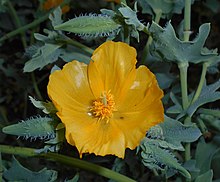Yellow Horned-poppy
| Yellow hornpoppy | |
|---|---|
 |
|
| Scientific classification | |
| Kingdom: | Plantae |
| (unranked): | Angiosperms |
| (unranked): | Eudicots |
| Order: | Ranunculales |
| Family: | Papaveraceae |
| Genus: | Glaucium |
| Species: | G. flavum |
| Binomial name | |
|
Glaucium flavum Crantz |
|
Glaucium flavum (yellow hornpoppy or yellow horned poppy) is a summer flowering plant in the Papaveraceae family, which is native to Northern Africa, Macronesia, temperate zones in Western Asia and the Caucasus, as well as Europe. Habitat: the plant grows on the seashore and is never found inland. All parts of the plant, including the seeds, are toxic and can produce a range of symptoms up to and including respiratory failure resulting in death FDA poisonous plants database. It is a noxious weed in some areas of North America, where it is an introduced species. The thick, leathery deeply segmented, wavy, bluish-grey leaves are coated in a layer of water retaining wax. The sepal, petals and stamen have a similar structure and form to the Red Poppy (Papaver rhoeas) except the sepals are not hairy. Prolific quantities of seeds are held in a distinctive horn shaped fruit some 15 to 30 cm in length, which is divided into two chambers.
A poppy grows upon the shore,
Her leaves are glaucus-green and hoar,
She has no lovers like the red,
Her blossoms on the waves are shed,
Sea Poppies
Amber husk fluted with gold, fruit on the sand marked with a rich grain,
treasure spilled near the shrub-pines to bleach on the boulders:
your stalk has caught root among wet pebbles and drift flung by the sea and grated shells and split conch-shells.
Beautiful, wide-spread, fire upon leaf, what meadow yields so fragrant a leaf as your bright leaf?
Glaucine is the main alkaloid component in Glaucium flavum.Glaucine has bronchodilator and antiinflammatory effects, acting as a PDE4 inhibitor and calcium channel blocker, and is used medically as an antitussive in some countries. Glaucine may produce side effects such as sedation, fatigue, and a hallucinogenic effect characterised by colourful visual images, and as a recreational drug. For a detailed bibliography on Glaucine and Glaucium flavum see: National Agricultural Library (Glaucium flavum entry)
...
Wikipedia
